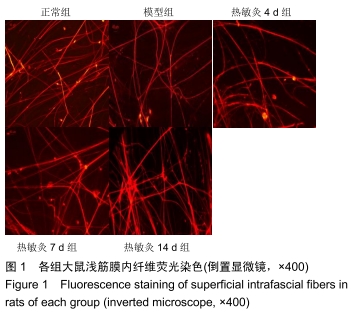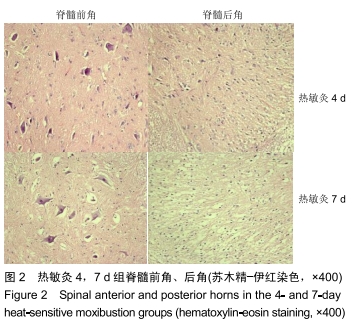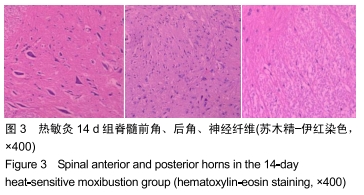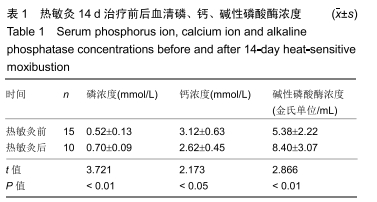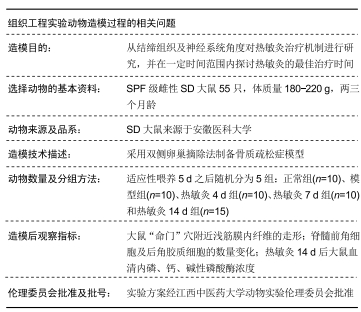中国组织工程研究 ›› 2020, Vol. 24 ›› Issue (20): 3135-3139.doi: 10.3969/j.issn.2095-4344.2554
• 骨组织构建 bone tissue construction • 上一篇 下一篇
不同疗程热敏灸干预骨质疏松症模型大鼠穴位周围结缔组织及脊髓的形态学变化
吴慧婷,崔田田,欧阳厚淦,欧阳彦楚,易 岚,陈 楚
- 江西中医药大学,江西省南昌市 330004
Effect of different courses of heat-sensitive moxibustion on the morphology of surrounding connective tissue and spinal cord in a rat model of osteoporosis
Wu Huiting, Cui Tiantian, Ouyang Hougan, Ouyang Yanchu, Yi Lan, Chen Chu
- Jiangxi University of Traditional Chinese Medicine, Nanchang 330004, Jiangxi Province, China
摘要:
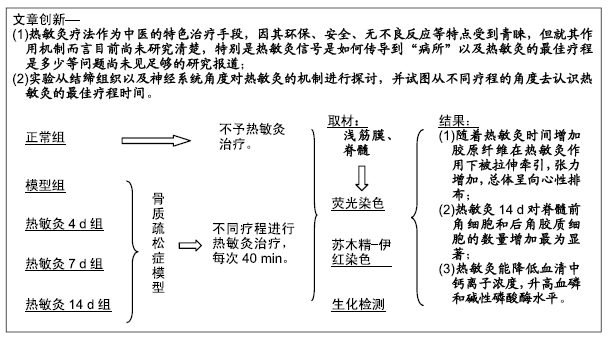
文题释义:
热敏灸疗法:是以中医的经络穴位为基础,通过艾灸体表的“热敏化穴”,以求产生一种“小刺激大反应”的效果,即激发透热、扩热、传热、局部不(微)热远部热、表面不(微)热深部热、非热觉等热敏灸感,出现的一种酸胀、重痛、麻酥等数种灸疗现象,促进气血运行,直达病所。
浅筋膜:居于真皮之下,薄软且富有弹性,由疏松结缔组织构成,主要包含大量基质、弹性纤维、胶原纤维和未分化的间充质细胞等,具有维持人体正常体温和保护深面组织的重要作用。
背景:通过临床实践和基础实验证明针灸“命门”穴对治疗原发性骨质疏松症疗效显著,热敏灸作为一种新型治疗手段,在临床治疗中收效甚益,但对其机制的研究仍处于空白阶段。
目的:拟从结缔组织及神经系统角度对热敏灸治疗机制进行研究,并在一定时间范围内探讨热敏灸的最佳治疗时间。
方法:将SPF级雌性SD大鼠随机分为5组:正常组、模型组、热敏灸4 d组、热敏灸7 d组、热敏灸14 d组,后4组通过双侧卵巢摘除术制备骨质疏松症模型,给予不同时间热敏灸治疗,治疗结束后取以“命门”穴为中心区附近0.5-1.5 cm内的皮下浅筋膜、脊髓分别进行荧光染色、苏木精-伊红染色;对热敏灸14 d治疗前后的血清磷、钙离子和碱性磷酸酶浓度进行测定。
结果与结论:①荧光染色观察筋膜内纤维形态改变:模型组的胶原纤维排布交错杂乱呈网状排列,而热敏灸4 d组胶原纤维排列几乎没有任何改变,随着热敏灸时间延长至14 d变化逐渐显著,胶原纤维在热敏灸作用下被拉伸牵引,张力增加,总体呈向心性排布,即朝向“命门”穴附近;②苏木精-伊红染色观察脊髓改变:热敏灸4 d组大鼠脊髓较模型组无明显变化,热敏灸7 d组前角处神经元细胞数量有所增加且体积增大,后角处神经胶质细胞数量增加,热敏灸14 d组前角神经元细胞数目增加显著,且体积增大,细胞核较大而圆,核仁明显,神经纤维增粗增长,排列规律,后角处神经胶质细胞数目明显增加且更加致密;③血清指标:经热敏灸14 d治疗前后对比发现大鼠血清磷离子、碱性磷酸酶浓度明显上升(P < 0.01),钙离子浓度明显下降(P < 0.05);④结果提示,热敏灸可以通过结缔组织形态学改变以及神经-体液调节来实现热敏信号通路的传导,进而改善骨质疏松的症状,以热敏灸14 d为理想治疗时间。
ORCID: 0000-0002-1232-2061(吴慧婷)
中国组织工程研究杂志出版内容重点:组织构建;骨细胞;软骨细胞;细胞培养;成纤维细胞;血管内皮细胞;骨质疏松;组织工程
中图分类号:
